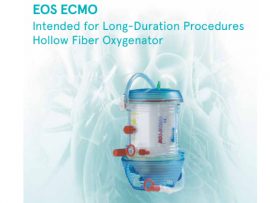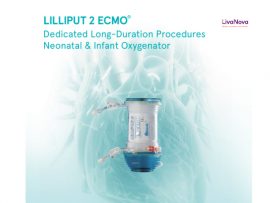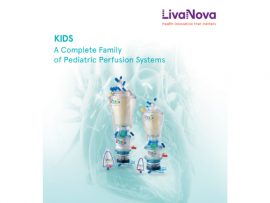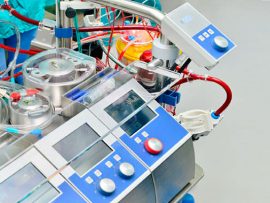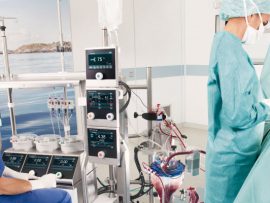Abstract Extreme prematurity carries a high burden of morbidity and mortality. The artificial placenta is an emerging therapy that has the potential to improve outcomes in these patients. However, current..
Read MoreAbstract Chronic respiratory diseases claim nearly four million lives annually, making them the third leading cause of death worldwide. Extracorporeal membrane oxygenation (ECMO) is often the last line of support..
Read MoreAbstract This case report discusses a rare and critical perfusion accident during a minimally invasive coronary artery bypass grafting (CAGB) procedure, where a Eurosets Skipper oxygenator burst 3 minutes after..
Read MoreAbstract Although extracorporeal membrane oxygenation (ECMO) systems have been used to provide temporary support for patients with severe respiratory or cardiac failure, they are often bedridden, in part because of..
Read MoreAbstract Oxygenator high-pressure (HPE) is a phenomenon that can occur during cardiopulmonary bypass (CPB) in which the oxygenator inlet pressure increases rapidly, thereby limiting flow. Most perfusionists globally do not..
Read MoreAbstract Established clinical monitoring techniques lack predictive capabilities, emphasizing the need for refinement in MO monitoring towards an early warning system. In this study, an MO was modified by integrating..
Read MoreAbstract Introduction Polymethylpentene (PMP) oxygenators serve as the primary oxygenator type utilized for ECMO. With the number of PMP oxygenators available, it has become increasingly important to determine differences among..
Read MoreAbstract This article introduces an open-source tool to experimentally compare blood residence time in biomedical devices using an image-based method. The experimental setup and the postprocessing workflow are comprehensively elucidated..
Read MoreAbstract Introduction: The optimal timing for extracorporeal membrane oxygenation (ECMO) circuit change-out is crucial for the successful management of patients with severe cardiopulmonary failure. This comprehensive review examines the various..
Read MoreAbstract Introduction The performance of an oxygenator, as found in literature, is evaluated according to protocols that define standard values of the gas content in the inlet blood. However, when..
Read MoreAbstract Refurbishing single use extracorporeal membrane oxygenation (ECMO) oxygenators for in vitro research applications is common. However, the refurbishment protocols that are established in respective laboratories have never been evaluated. In the present study, we aim at proving..
Read MoreAbstract Introduction: Cardiopulmonary bypass (CPB) machines have oxygenators with integrated filters and unique biocompatible coatings to combat systemic inflammatory response syndrome (SIRS) and mitigate coagulopathy. Contemporary oxygenators have undergone comparative..
Read MoreAbstract Introduction The novel Capiox NX19 adult oxygenator is, compared to its predecessors, improved with enhanced air removal technology, a polymer heat exchanger and smaller, innovative hollow fibers resulting in..
Read MoreComparison of bubble removal performances of five membrane oxygenators with and without a pre-filter
Abstract When employing minimal invasive extracorporeal circulation (MiECC), the removal of bubbles in the circuit is important to prevent air embolism. We investigated the bubble removal performance of the FHP..
Read MoreAbstract Purpose The primary aim of this study was to examine the effects of two oxygenator systems on major adverse events and mortality. Methods A total of 181 consecutive patients..
Read MoreEOS ECMO is part of the LivaNova ECMO oxygenators family. Equipped with the well known Polymethylpentene Hollow Fiber, it guarantees optimal performance for Pediatric and Adult patients undergoing long duration..
Read MoreAbstract The recent emergence of microfluidic extracorporeal lung support technologies presents an opportunity to achieve high gas transfer efficiency and improved hemocompatibility relative to the current standard of care in..
Read MoreAbstract Extracorporeal membrane oxygenation (ECMO) plays an important role in the coronavirus disease 2019 (COVID-19) pandemic. Management of thrombi in ECMO is generally an important issue; especially in ECMO for..
Read MoreAbstract Purpose: Purpose: Condensation that clogs the hollow fibers of the oxygenation and accumulation of plasma leaks reduces oxygenated lung capacity. In this study, artificial We evaluated whether monitoring changes..
Read MoreAbstract Extracorporeal membrane oxygenation is a life-saving intervention, but bleeding complications are frequent. Given that the combination of platelet loss and dysfunction is a major contributor to this acquired bleeding..
Read MoreAbstract Extra Corporeal membrane oxygenation (ECMO) is one of the most advanced forms of life support therapy in the Intensive Care Unit. It relies on the principle where an external..
Read MoreAbstract Background: Monitoring oxygen delivery to the oxygenator of a heart lung machine (HLM) is typically accomplished with an O2 analyzer connected to the gas inflow line. It is assumed when..
Read MoreAbstract Background: Monitoring oxygen delivery to the oxygenator of a heart lung machine (HLM) is typically accomplished with an O2 analyzer connected to the gas inflow line. It is assumed when..
Read MoreAbstract In order to assess mechanisms underlying inflammatory activation during extracorporeal circulation (ECC), several small animal models of ECC have been proposed recently. The majority of them are based on..
Read MoreAbstract During cardiopulmonary bypass (CPB), gaseous microemboli (GME) are released into the patients’ arterial bloodstream. Gaseous microemboli may contribute to the adverse outcome after cardiac surgery. Recently, two oxygenator models..
Read MoreAbstract Advances in cardiopulmonary bypass equipment have played a critical role in improving outcomes for cardiac surgery patients. Recent advancements include reduced priming volumes, biocompatible coatings and gaseous microemboli handling,..
Read MoreAbstract Background: Administering isoflurane 2.5% into the oxygenator during cardiopulmonary bypass results in no patient movement. However, doing so may result in an excessive depth of anaesthesia particularly, when hypothermia..
Read More




